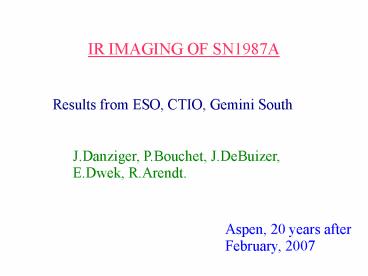IR IMAGING OF SN1987A - PowerPoint PPT Presentation
1 / 25
Title:
IR IMAGING OF SN1987A
Description:
What are the main issues concerning dust in SNe? ... b. Day 6526-day 6067. divided by day 6067. c. Image from (b) over. laid with 6067 contours ... – PowerPoint PPT presentation
Number of Views:56
Avg rating:3.0/5.0
Title: IR IMAGING OF SN1987A
1
IR IMAGING OF SN1987A
Results from ESO, CTIO, Gemini South
J.Danziger, P.Bouchet, J.DeBuizer, E.Dwek,
R.Arendt.
Aspen, 20 years after February, 2007
2
DUST in SUPERNOVAE
What are the main issues concerning dust in SNe?
1. Do SNe produce most of the dust in our Galaxy
and in galaxies at high redshifts. 2. Is most of
this dust formed in the SN envelope or in the
CSM formed before the explosion. 3. What is the
composition of any dust formed. 4. Do all
core-collapse SNe produce dust. 5. Why are there
differences in phase for dust production. 6. Why
are there apparent differences in concentration
of dust in SN envelopes. 7. Will predicted
blackouts occur (have occurred?). 8. Does dust
survive the SN environment.
3
Early Near-IR
Ejecta not resolved extension due to ring
4
He I 10830
November, 2001, day 5379 OSIRIS, CTIO
January, 2005, day 6535 OSIRIS, CTIO
5
T/ReCS - Gemini South
S?????? ??? IMAGES
Day 6526
Day 6067
Note ejecta detected days 6067 and 7241
Day 7241
6
Q-band (18.3?) Imaging
Day 6067
Day 6526
Q-band contours overlaid N band image
7
Day 6526
Using the 11.7 and 18.3? images from TreCS, and
silicate composition established from SPITZER.
Temperature Emission Optical
Depth of dust
Average very small 5.5x10-6 per pixel
8
QUICK SUMMARY
Day 6067
Average T in ring 18020-10K Dust Mass in ring
1-8x10-5M? T in ejecta 90KltTlt100K Dust mass
in ejecta 10-4 - 2x10-3M?
Day 6526
Dust T in ring 16618-12K Dust mass in ring
2.62.0-1.4x10-6M?
Latter values more accurate because silicate dust
was identified and used instead of BB assumption
in the former.
9
Comparison of 10? Images at days 6067 and 6526.
a. Day 6526-day 6067 b. Day 6526-day
6067 divided by day 6067 c. Image from (b)
over laid with 6067 contours d. Image from (b)
over laid with 6526 contours
Contours range -50,150,250,350,700 percent.
10
Overlay of Xray (ACIS) contours with 11.7 and
18.3? images at day 6526.
11
ATCA 12mm contours at day 6002 overlaid
with TreCS images 11.7 and 18.3?, day 6526.
ATCA image 12mm at day 6281 overlaid with
contoured TreCS images at day 6526.
12
HeI 1.083? day 5749 contour overlaid on 10? day
6067 image. (OSIRIS)
H?NII day 5555 contour overlaid on 10? day
6067 image. (HST)
13
a. Mid-IR (11.7) overlaid with HST F625W
image. b. Same with HST convolved to resolution
of T-ReCS image. c. Qa (18.3) overlaid with HST
F625W image. d. Same with HST convolved as in
(b).
a. T-ReCS (11.7) overlaid with HST UVO (6502
days) contours. b. 11.7m image deconvolved with
Max. Entropy Method overlaid with HST above.
Suggests IR/dust in bright knots.
14
IR Light Curves
x
x
These light curves tell us that the IR ring
emission started to increase near day 3800 and
dominated after that as it steadily increased in
luminosity. Another major increase occurred near
day 6000.
15
x
The increases in the IR coincide with increases
in Xrays and probably radio.
16
H-band image with VLT NACO - Oct. 9 2006
17
TreCS N band day 7241
18
Ratio of images day 7241/6067
19
SUMMARY INCLUDING NEW TReCS OBSERVATIONS
Difference day7241-day 6067
1. Day 7241 shows IR emission from complete
ring. 2. At 10-11.7 m flux from ring has
increased continously 6067 - 9.9mJy 6526 -
18.4mJy 7241 - 26.0mJ.
Flux from ejecta. Day 6067 - 0.3mJy 7241 - 0.50
mJy.
Reverse shock?
20
BRIEF GENERAL SUMMARY OF OBSERVATIONS IR
observations now show dust in ring collisionally
heated by shock interaction with outer SN
envelope. This started in an obvious way near
day 3800. It has increased monotonically since
then with a major increase near day 6000. Dust
still in ejecta probably mostly heated by
radioactive decay. Silicate dust in ring
(SPITZER) Silicate dust in ejecta (Lucy et
al) Amorphous carbon in ejecta (Ercolano et al)
21
END of PRESENTATION
22
Ratio of day 7241/6067
Difference 7241 - 6067
23
(No Transcript)
24
A Brief Summary of Dust in Supernova
1. Early IR excess in 87A from ff and dust in CSM
not ejecta. Ejecta too hot, CO (112days) and SiO
(160days) molecules formed much later than IR
excess. 2. Dust after day 530 in ejecta (line
profiles, IR excess included in BLC fit to
models). 3. Composition of ejecta dust silicates
(Lucy et al.), carbon (Ercolano et al.). 4. Mass
of dust few x 10-4 (Lucy et al., Ercolano et
al.) but gt0.1 Mo if in opaque clumps and SiI
1.64m line behaviour indicates depletion. 5.
Dust formed at different phases. SN1987A -
530days 1999em - 500days 1998S - 300days
2003gd - 499days 1990I - 230days. 6. Dust in
ejecta forms in different concentrations.
SN1987A - velocities below 1870km/s 1999em -
velocities below 800km/s. 7. Large variations in
CSM dust masses. 8. Silicate dust in ring of
SN1987A.
25
(No Transcript)































